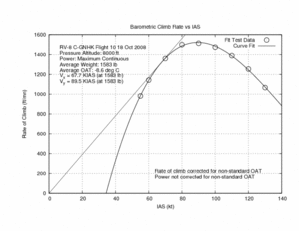Hawk One First Flight
- Details
- Written by Kevin Horton
- Hits: 3623
As many of you know, I plan to paint my aircraft in an RCAF Golden Hawks paint scheme. 2009 is the 50th anniversary of the formation of the Golden Hawks, and Vintage Wings of Canada in Gatineau has acquired a Canadair Sabre that they plan to paint in Golden Hawk colours to commemorate 100 years of powered flight in Canada and the 50h anniversary of the Golden Hawks. Hawk One blog. The aircraft has just come out of a rebuild, and did its first flight last week. Video.
Misc Update
- Details
- Written by Kevin Horton
- Hits: 4579
I was on the road all week, doing CRJ-700 high altitude airfield operations testing. The testing involved flying a whole bunch of different profiles, to evaluate various aspects of the modification to the pressurization system that allowed ops from airfields above 8000 ft pressure altitude. The testing culminated with two landings and take-offs from Telluride, CO. The 6,870 ft long runway at Telluride is in a bowl on top of a plateau, at 9080 ft elevation. The runway slopes down at -1.9% gradient to the middle, then up at +1.9% gradient to the far end. There is a very sharp cliff just off each end of the runway. The airport is surrounded by terrain up to 14,000 ft, except along a valley that comes in from the west.
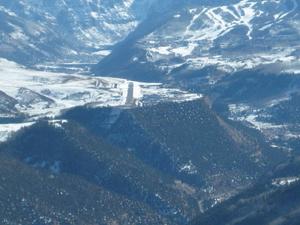 Landings are preferred on runway 09, to take advantage of the approach in the valley, and to avoid an expensive subdivision that is built right at the east end of the runway. If you have to land on runway 27, the noise abatement procedure has you aim at the button 15 degrees off the runway centreline, then turn on to the runway axis just before starting the flare. Not a big deal in a light aircraft, but it is a fairly sporty manoeuvre in a big regional jet. Last time I was there in the CRJ-700 we had to land on 27, but last week the winds were light, so we could use 09.
Landings are preferred on runway 09, to take advantage of the approach in the valley, and to avoid an expensive subdivision that is built right at the east end of the runway. If you have to land on runway 27, the noise abatement procedure has you aim at the button 15 degrees off the runway centreline, then turn on to the runway axis just before starting the flare. Not a big deal in a light aircraft, but it is a fairly sporty manoeuvre in a big regional jet. Last time I was there in the CRJ-700 we had to land on 27, but last week the winds were light, so we could use 09.
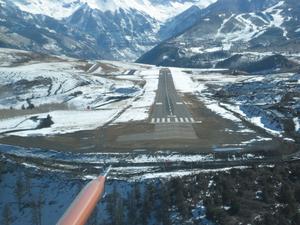 This is not a long runway for the CRJ-700. Landing distance is not a problem as long as the runway is dry, but accelerate-stop distance is critical for take-off.
This is not a long runway for the CRJ-700. Landing distance is not a problem as long as the runway is dry, but accelerate-stop distance is critical for take-off.
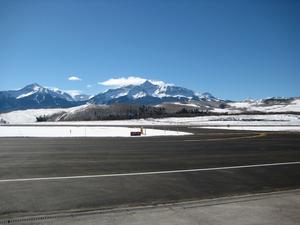 Someone claimed that this mountain visible south of Telluride is the one on Coors Light cans. Fact, or fiction? No idea. It didn’t seem appropriate to be asking for a Coors Light can to look at, as we were going to be taking off again in a few minutes.
Someone claimed that this mountain visible south of Telluride is the one on Coors Light cans. Fact, or fiction? No idea. It didn’t seem appropriate to be asking for a Coors Light can to look at, as we were going to be taking off again in a few minutes.
I went out to the hangar for a few hours today. I updated the Dynon EFIS software to the latest version, made some measurements of the prop governor so I know what angle to order for the control arm, measured for some cockpit storage I need to make, removed the turn and bank, so I can take it to a gyro shop (the gyro no longer spins), and tested out a bug fix to the EIS 4000 recording software.
The engine arrived at Aerosport Power, and they have disassembled it. The last e-mail I got said that Bart Lalonde would inspect it on Monday. Fingers crossed.
I’ve put a deposit on a PCU5000 prop governor. It seems to be the best of the currently manufactured governors, as near as I can tell. There is currently a pretty good discount available as part of a group buy organized on the VAF WWW forums.
Static Source Position Error in Altitude
- Details
- Written by Kevin Horton
- Hits: 3131
The pitot-static system flight tests I did on flights 8 and 11 also allow the effect of the static source position error on the altitude indication to be determined.
 Here is the altitude error, at the test weight. The error is very small at low speed, but does start to increase as the airspeed increases. If the trend continues to higher speeds, the error should still be less than 35 ft at 200 kt.
Here is the altitude error, at the test weight. The error is very small at low speed, but does start to increase as the airspeed increases. If the trend continues to higher speeds, the error should still be less than 35 ft at 200 kt.
I will put correction charts in my POH, but given the small errors I will probably not calculate corrections for other weights.
Static Source Position Error Flight Test Results
- Details
- Written by Kevin Horton
- Hits: 6473
I gathered a bunch of airspeed error data on flights 8 and 11, over two weeks ago, and this week I finally did some detailed analysis of the data. The basic test and analysis method is described in my Determining Static System Error document.
The test technique was to fly a four leg box pattern at each test speed, being careful to fly as closely as possible to the target IAS and altitude, at a constant heading. On each leg, I recorded GPS track and ground speed and OAT. My laptop computer was also recording data from the EFIS, GPS, and engine monitor to supplement the hand-recorded data. I flew a range of speeds from 55 to 180 KIAS. The bulk of the testing was done at 3500 or 7500 ft, to be in smooth air. I couldn’t maintain 180 KIAS at altitude, but I managed to find smooth air at 1500 ft early one morning.
Post flight, I used the GPS data to determine the TAS for each test point, using Doug Gray’s method, using the NTPS spreadsheet. I corrected the indicated OAT for the probe’s ram temperature recovery factor (my test results show the recovery factor is somewhere between 0.8 and 0.95, depending on how you look at the data - I am using 0.85 for my analysis here, but the results don't change significantly if I change the assumed recovery factor to 0.8 or 0.95). I used the TAS and corrected OAT to determine CAS. I used the results of my EFIS ASI instrument error ground test to correct the IAS, and the difference between the corrected IAS and the CAS must be due to static source position error.
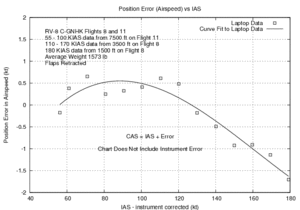 I was very pleased to see that the static source position error is very low. The error is less than 1 kt at speeds up to 160 kt, and increases to about 1.7 kt at 180 KIAS. The error would make the IAS read too low at low speed, and read too high at high speed.
I was very pleased to see that the static source position error is very low. The error is less than 1 kt at speeds up to 160 kt, and increases to about 1.7 kt at 180 KIAS. The error would make the IAS read too low at low speed, and read too high at high speed.
I am using Van's standard "pop-rivet" static ports, and a AN5812 pitot tube.
The theory says that the error will be a function of angle of attack, and the relationship between angle of attack and speed varies with weight. So, the airspeed error vs IAS curve would change slightly with weight. But, the error is small enough that I am not in a rush to calculate the corrections for other weights.
Note that this chart does not include the EFIS ASI instrument error.
 I determined the EFIS and analog ASI instrument errors using a water manometer. I did the test twice, and got similar results. This chart shows the total airspeed system error = instrument error + static source position error for the EFIS.
I determined the EFIS and analog ASI instrument errors using a water manometer. I did the test twice, and got similar results. This chart shows the total airspeed system error = instrument error + static source position error for the EFIS.
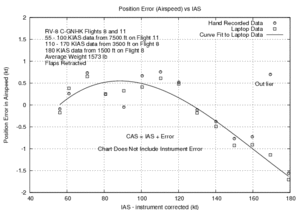 I was quite surprised to see how closely the hand recorded data matched up to the data recorded on the laptop. I stabilized on each leg of the four leg box for about one minute, recording the data on a knee board when everything seemed to be nicely stabilized. Post-flight, I studied the data on the laptop, looking for the most stable section of each leg of the box, and carefully selected the start and end times to analyze for each leg so the average IAS matched the target within 0.05 kt, and the altitude matched the target altitude within 20 ft. I averaged the GPS track and groundspeed for each of those legs, and used those averages to calculate the TAS.
I was quite surprised to see how closely the hand recorded data matched up to the data recorded on the laptop. I stabilized on each leg of the four leg box for about one minute, recording the data on a knee board when everything seemed to be nicely stabilized. Post-flight, I studied the data on the laptop, looking for the most stable section of each leg of the box, and carefully selected the start and end times to analyze for each leg so the average IAS matched the target within 0.05 kt, and the altitude matched the target altitude within 20 ft. I averaged the GPS track and groundspeed for each of those legs, and used those averages to calculate the TAS.
The results calculated from the hand recorded data matches up extremely closely to the results calculated from the data on the laptop, except for an aberration at 170 KIAS. There is clearly something wrong with the hand-recorded data at 170 kt. It differs from the laptop data by about 2 kt, and is clearly out of line with the rest of the hand recorded data. I probably wrote down one of the numbers wrong. The problem was evident when I looked at the standard deviation in the NTPS spreadsheet - this one showed about 2 kt standard deviation whereas the rest of the hand recorded data had a standard deviation of about 0.5 kt.
Engine Removal, Prop Order
- Details
- Written by Kevin Horton
- Hits: 4253
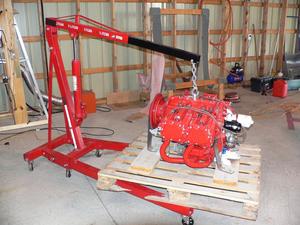 Yesterday I finished disconnecting everything from the engine, and pulled it off the aircraft. I placed the bottom of the crate on top of the engine hoist legs, and carefully lowered the engine and bolted it in place.
Yesterday I finished disconnecting everything from the engine, and pulled it off the aircraft. I placed the bottom of the crate on top of the engine hoist legs, and carefully lowered the engine and bolted it in place.
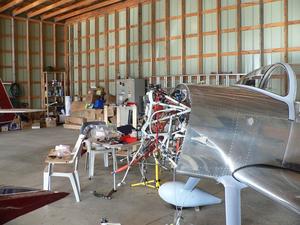 The poor aircraft looks pretty sad without an engine.
The poor aircraft looks pretty sad without an engine.
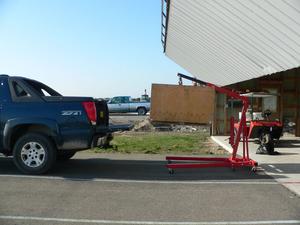 This morning I secured the crate sides in place, then hooked the hoist back up to the engine, and lifted the engine and crate high enough to get them in the back of a borrowed pickup truck. I delivered the crate to the shipping company after lunch. I’ve no idea how long it will take to get to Aerosport Power.
This morning I secured the crate sides in place, then hooked the hoist back up to the engine, and lifted the engine and crate high enough to get them in the back of a borrowed pickup truck. I delivered the crate to the shipping company after lunch. I’ve no idea how long it will take to get to Aerosport Power.
I ordered a new 3-bladed MT MTV-12-B-C/C183-59B counterweighted prop. This prop will go to coarse pitch if the engine has an oil pressure interruption. Earlier variants of the 3-bladed MT prop were reported to provide much lower performance than Hartzell propellors on RVs. But, the newer 183-59B blade appears to me much improved, and I expect that it will provide roughly equal performance to the Hartzell prop that I was previously using. The newer “blended airfoil” Hartzell props probably offer better performance than the newest MT props, but those Hartzell props are not available with counterweighted blades. If I wanted to purchase a Hartzell with counterweighted blades, I would have to purchase the same older 7666 blade design as my current prop. I considered purchasing one of those, but the spinner would be too large, and I wasn’t prepared to deal with the major cowling modifications that would be required.
I also need to purchase a new propellor governor, as the one I currently have sends oil pressure to the prop to force it to coarse pitch, and the new prop needs oil pressure to send it to fine pitch. I’ll almost certainly purchase a PCU5000 prop governor, as it seems to be the best of the currently manufactured ones. I’ll probably participate in the group buy that has just started on the VAF WWW site.
Climb Test Results
- Details
- Written by Kevin Horton
- Hits: 5298
Saturday last weekend, the day before the big engine overspeed, I did some climb performance testing. I had hoped to do the climbs centred on 5000 ft, but the air wasn't smooth enough. I found smooth air between 7000 ft and 9000 ft, so did the climbs centred on 8000 ft.
The aircraft was loaded as per a solo flight - just me, full fuel and no baggage. The average weight for all the tests was 1583 lb. I did two climbs at each speed, on reciprocal headings at 90 degrees to the forecast wind, starting below 7000 ft so I was nicely stabilized on speed at 7000 ft, and continuing past 9000 ft. I used the recorded data to get the average rate of climb for each run from 7000 ft to 9000 ft, and averaged the rates of climbs for the two runs at each speed. I then did a curve fit on the raw data, and found that Vy at that weight was about 90 KIAS, and Vx was about 68 KIAS.
I'll repeat this test condition with the new prop, and also at gross weight. Eventually I'll correct the results for the effect of OAT on the engine power
Based on these results, I would expect that Vy at 1800 lb would be about 95 KIAS.
